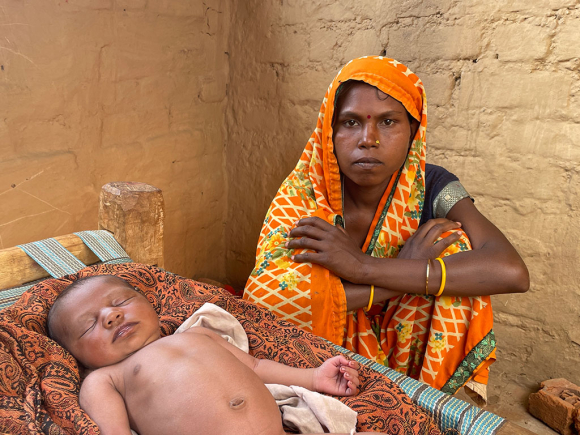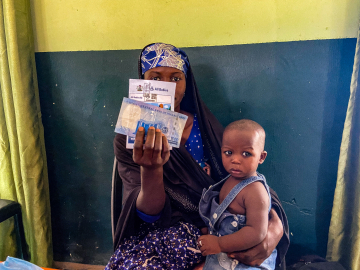Millions of India’s Women Brick Kiln Workers Find Health Care Elusive
RAJASTHAN, India — On the evening of March 10, pregnant brick kiln worker Shakundevi* felt a sharp pain in her abdomen.
She traveled 3 kilometers (nearly 2 miles) to a government health care center in Rajasthan’s Bhilwara district. The health workers told her to come back the following day for an ultrasound. But by 2 a.m., her pain worsened, and she was in labor. The brick kiln owner called an ambulance, but she gave birth in her hut before it arrived.
After giving birth to a baby girl, she recuperated for less than two weeks. When her husband was assigned a new task, she had to cover for him at the brick kiln. “It was around noon, and the heat was intense,” recalled Shakundevi, who worked for an hour but had to stop when she felt another pain in her abdomen.
“It hasn’t subsided, so I am going to the hospital today,” she said one day last spring.
Women like Shakundevi make up 30–50% of workers in India’s brick kilns, per a 2020 Prayas Centre for Labour Research and Action report. A key part of a massive migrant workforce that produces India’s bricks, the women kiln workers face considerable barriers to health care, including: a lack of proper documents, distant health care centers, and the loss of income when not working, according to interviews with workers in Rajasthan’s Ajmer and Bhilwara districts.
Every year after the monsoon season ends (usually in September), 10 to 23 million workers travel to India’s kilns (the second largest brick industry in the world). There they will spend about nine months living in small, cramped temporary huts. The kilns, which rely on debt bondage, are recognized as exploitative workplaces and are known sites of modern-day slavery. Contractors usually hire families as a unit to work in the kilns, based on paltry advances that the workers must repay. The family, including children, work through the season to pay off the debts, earning just around $6 (Rs 500) for 1,000 molded bricks.
Recovery Cut Short
In late March 2023 in Bhilwara, Nirmala was handing clay to her husband Maniram who was molding bricks when she heard her 3-month-old baby Karthik cry after waking from a nap. Washing her hands, she picked up her baby, and said, “I work all day, and when he wakes up and starts crying, I go to feed him and put him to sleep.”
Nirmala had given birth at a government hospital in Ajmer through a caesarean section. Generally, women who have had a caesarean section are recommended to rest for around 6 weeks before engaging in any strenuous physical activity. But Nirmala returned to work 15 days after giving birth.
“I started as soon as I could because we have to earn,” said Nirmala, “How else will we pay off our debts?”
The couple had come to the kilns in late October 2022 with an advance of $360 (Rs 30,000). They needed the money to pay off the loan they had taken to complete building a house in their village.
Despite working continuously for five months, the couple had not been able to pay back the advance. It’s a common situation, according to a survey by the Centre for Labour Research and Action (CLRA). The research, based on interviews with more than 750 families working in brick kilns in Ajmer and Bhilwara districts between 2016 and 2019, found that 30–40% of the workers had existing debts with the average debt amounting to $1,240 (Rs 103,100).
Because most of the workers are paid based on the number of bricks they mold, load, or unload, resting means loss of pay and mounting debts. So, despite needing to recover postpartum, Shakundevi and Nirmala had to get back to work. Female laborers, on average, spend 8 hours and 35 minutes making bricks per day and 8 hours on household activities, according to a 2017-18 International Labour Organization (ILO) working paper by CLRA.
“If we just sit, eat, and feed the children, we will go into loss,” said Shakundevi, “The seth [kiln owner] said that we will have to pay off the debt—and to start working.”

Shakundevi, 25, sits with her baby daughter in a hut near brick kiln in Rajasthan’s Bhilwara district on March 29. Shreya Raman
Impacts on Health Care
Maniram was still molding bricks when Nirmala came outside after feeding Karthik. Her baby kept jumping, while Nirmala tried to hold him. “He does not sleep all night,” said Nirmala, “Because mosquitoes keep biting him. So, we also don’t sleep.”
Karthik had had a cold for a few days. In addition to giving him a syrup prescribed by a private doctor, Nirmala has tied a necklace made of garlic cloves around his neck. “This will make the cold go away faster,” she said.
Babies like Karthik who were born during the migration or those who migrated often were more likely to be stunted compared to those who migrated once, per a 2022 Journal of Global Health study of 2,500 children in Bihar’s brick kilns. More than half (51.6%) of the children in the study were stunted. Key underlying factors for their malnutrition were lack of food security, access to health care, and sanitation.
One reason it’s difficult for kiln workers to access health care is because of India’s pollution control policies that require a brick kiln to be at least 800 meters from places of habitation. Most of the kilns Global Health NOW visited in Rajasthan were two to three kilometers from villages where public health care centers were located.
In addition, brick kiln workers were completely dependent on owners and supervisors and their perception of seriousness of an illness, according to 2018 doctoral thesis research in Bihar by Harvard T.H. Chan School of Public Health’s Christine Bohne. For example, Shakundevi could get an ambulance while in labor only because the owner called for it.
Barriers like this also make it hard for community-level health workers like Accredited Social Health Activists (ASHAs) to check up on the women in the kilns. The Bihar study found that just 5.3% of the children had an interaction with a frontline health worker. A study from Haryana state, based on interviews with 500 women, found only 23% of pregnant women had institutional deliveries. The researchers also found that a visit by a health worker or an ASHA was an important predictor for maternal health care utilization.
Gender-Based Violence
Fifteen-year-old Kavita* works in a Bhilwara brick kiln but just wants to return to her village and continue her education. “Please send me back to school,” said Kavita, “I want to finish my education. I don’t want to be in the brick kilns.” Since coming to the kiln, Kavita has joined her parents in unloading bricks from the kiln while also doing household work.
“My father drinks a lot of alcohol and hurls abuses and beats my mother,” said Kavita, “She has fallen sick because of it. He does not let her eat, sleep, or rest. No wonder she has a fever.” Female workers in the kilns, per the 2017-18 ILO working paper, often endure gender-based violence as well as sexual harassment by supervisors and intimate partner violence.
Because of migration and the gender-based power dynamics, women have limited recourse. Abha*, a migrant from Bihar, says she has no way to escape the violence perpetrated by her husband. “He beats me up and throws me out of the hut and tells me to get lost,” said Abha, “Where will I go? He does not even come after a few hours looking for me. I cannot just go home [to Bihar] because it is so far.”
Health care workers are often among the first—and only—points of contact for the survivors of gender-based violence, but the lack of access to them and to health care leaves many women brick kiln workers with few options.
Disenfranchisement and a Lack of Documents
Many workers who travel to the kilns also fail to bring relevant documents with them, making it difficult to access health facilities. Because health is a state responsibility in India, different states have different policies and migration of the workers alienates them from health policies in destination states.
Brick kiln workers living for eight months in the kilns and four months in their home villages are disenfranchised from the health care system in both the states. “There is no interlinkage between different states for health or education schemes and policies, and it severely impacts access for migrant brick kiln workers,” said Asha Verma, CLRA's Ajmer district coordinator.
The lack of a Mother and Child Protection card (called “the Mamta card”) that tracks mother and child’s health, nutrition, and development makes it difficult for them and their babies to get vaccinations, said Verma, adding that it’s a “constant struggle” to persuade health care workers to provide vaccinations and other services.
“We are constantly fighting with the government departments and health care providers,” said Verma, “We tell them that she might not have the card, but she is in need. She is seven months pregnant, so she needs the vaccination.”
*Names changed to protect sources’ privacy.
Shreya Raman is an independent journalist based in Mumbai and Goa, India.
Ed. Note: This reporting was supported by the International Women’s Media Foundation’s Howard G. Buffett Fund for Women Journalists.
Join the 50,000+ subscribers in 170+ countries who rely on Global Health NOW summaries and exclusive articles for the latest public health news. Sign up for our free weekday newsletter, and please share the link with friends and colleagues.
A woman molds bricks for a kiln in Rajasthan’s Ajmer district on March 26, 2023. Shreya Raman




